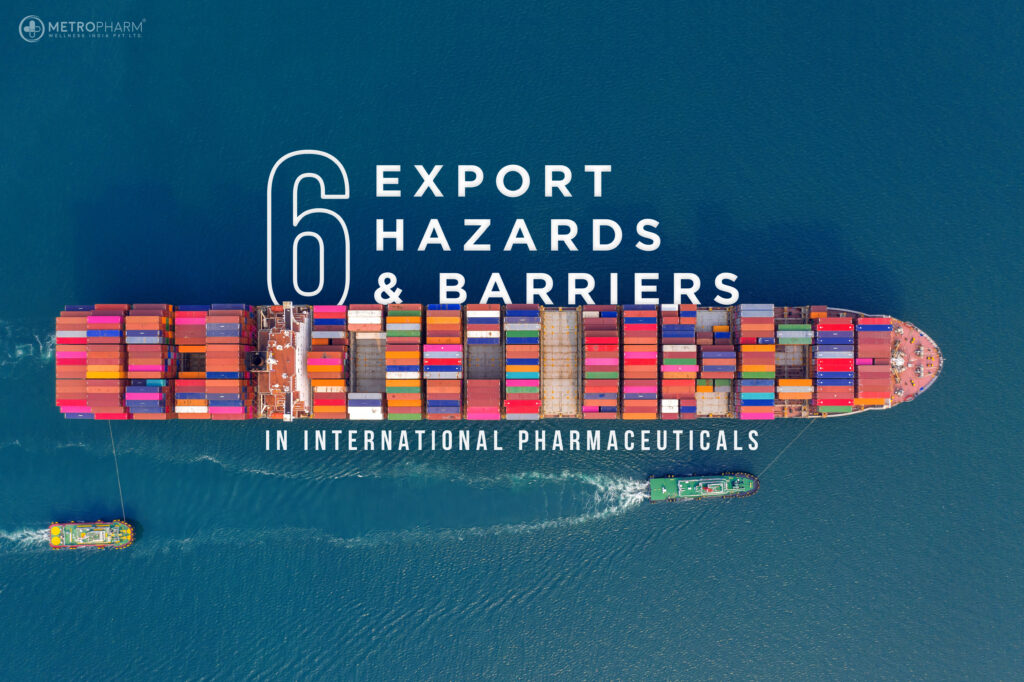
6 Export Hazards and Barriers in International Pharmaceuticals
In the last few years, the global pharmaceutical export business has experienced remarkable growth. While the demand for healthcare items to combat pandemics grew, several products saw a decline at the same time. “The worldwide pharma market growth declined by one or two percent in 2020,” according to the Pharmbiz research. The export of Indian pharmaceutical businesses, on the other hand, is currently booming. “Indian medicine and pharmaceutical exports increased by 4.58 % to $5.78 billion in the three months ending June 2021, opposed to $5.53 billion in the very same time the year before.”
In the pharmaceutical industry, maintaining stable exporting and distributing channels is difficult. Even though the pharmaceutical business employs a variety of strategies to ensure seamless exports, the preceding are some of the risks and problems associated with pharma exports.
Maintaining appropriate storage conditions during export
Maintaining appropriate storage settings for pharmaceutical products, whether they be APIs, excipients, or completed commodities, is critical for their safety and effectiveness. The conditions for storing an item differ from one to the next. Most medications, for instance, must be incubated at room temperature, while some specific products must be kept cold.
Assume that during exporting, proper storage standards are not maintained. In this scenario, it has a direct impact on the product’s quality as well as the welfare of the customer. Furthermore, imagine the goods degrade during transportation. It could result in a market recall, harming the company’s image and causing waste. As a result, maintaining storage conditions throughout export from the warehouses to the pharmacy stores becomes a difficult operation.

Maintaining records of the distribution line
The pharmaceutical distribution chain is made up of a coordinated network of manufacturers, wholesalers, and distributors who work together to make pharmaceuticals available to customers. Businesses need to make sure of effective product circulation in order to stay in the market for a longer period of time. Nevertheless, in poor nations, where so many pharma companies have yet to embrace digital supply-chain management, it is difficult to keep track of all activities. Shipping data are not always effectively kept, and there are no recordings of lost merchandise during transportation. Furthermore, one major stumbling block to this approach is that the health officials have not implemented rigorous and comprehensive standards for medication distribution. As a consequence, there is no control over the distribution system, making it difficult to track exports.

Handling supply of products during shortage/emergencies
In emergencies, such as disease outbreaks or the onset of a pandemic, most nations are unable to supply the demand for pharmaceuticals and preventive medical aid. In nations with a big population, meeting the demands becomes difficult due to a scarcity of producers and suppliers of scarce goods. Furthermore, travel bans and export/import bans have an impact on the product supply. When in an emergency, these variables can contribute to the supply of false and unauthorized medical products.
Managing the supply chain effectively
To guarantee protection for consumers, regulatory authorities have upped their pressure on pharmaceutical companies to produce high-quality medicines. Customers cannot identify flaws in therapeutic items via taste, smell, vision, touch, or aspect, as they do with food. As a result, maintaining product quality throughout the supply chain is critical. In the distribution chain, pharmaceutical items travel from manufacturers/suppliers to pharmacies/clinics. Many obstacles exist in this procedure, such as timely delivery of the product, maintaining temperature, inventory control, and keeping track of defective products, to name a few.

Adhering to rules and regulations of various countries
The drug delivery systems of underdeveloped and developed countries are vastly different. In advanced countries, a few companies control the majority of the national wholesale medicine market. In underdeveloped countries, on the other hand, the wholesale drug market is handled by hundreds or thousands of enterprises, resulting in inefficient drug distribution management. Furthermore, because regulatory standards differ from country to country, it is hard to export the very same commodity to numerous nations.
Fear of counterfeit drugs
Due to the weak distribution networks, global pharmaceutical is today facing a major challenge: fraudulent medications. Fake drugs are manufactured illegally and labeled with false information about their identity and source to make them appear legitimate. Consumers may not receive the therapeutic benefit expected from counterfeit drugs, which is one of the most serious dangers. It also has an impact on the company’s market reputation. The pharmaceutical industry and government regulators are still attempting to bring these criminal organizations of counterfeit medicines to an end.
Conclusion
We’ve talked about the potential dangers of exporting medicinal products. As a result, the pharmaceutical sector should adhere to the “good distribution practices for pharmaceutical commodities” requirements and take adequate precautions during exports.
